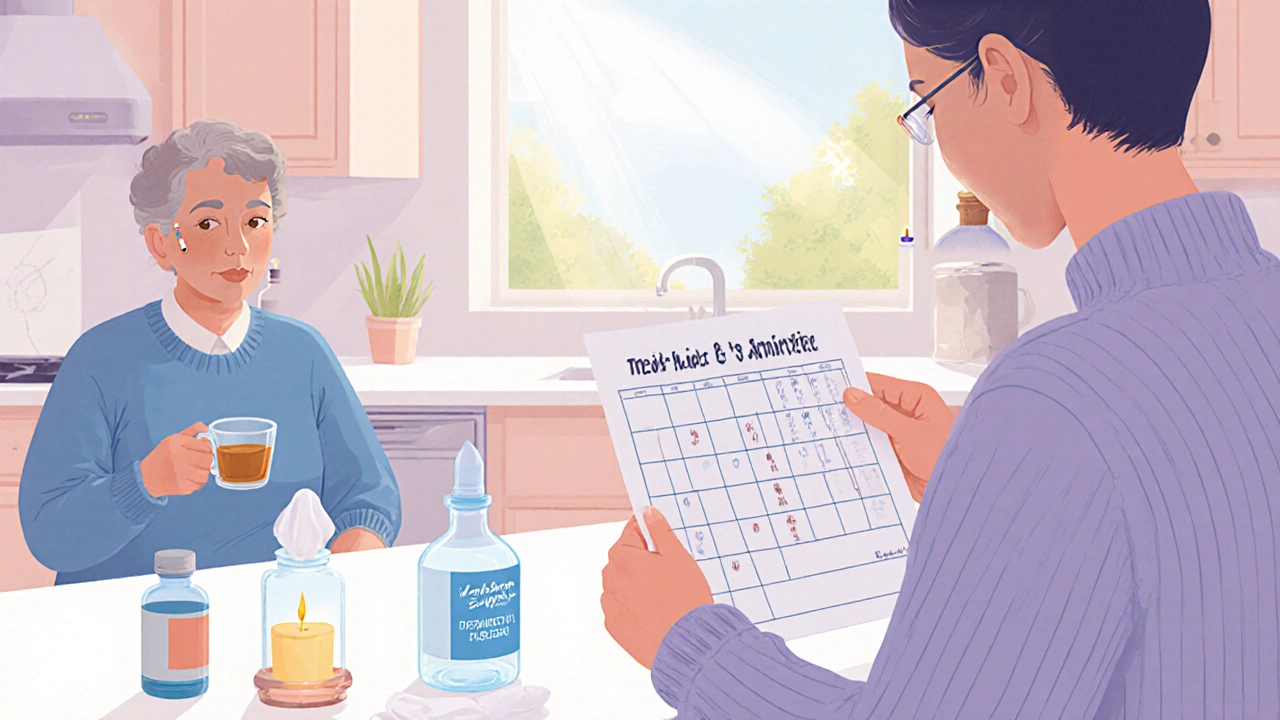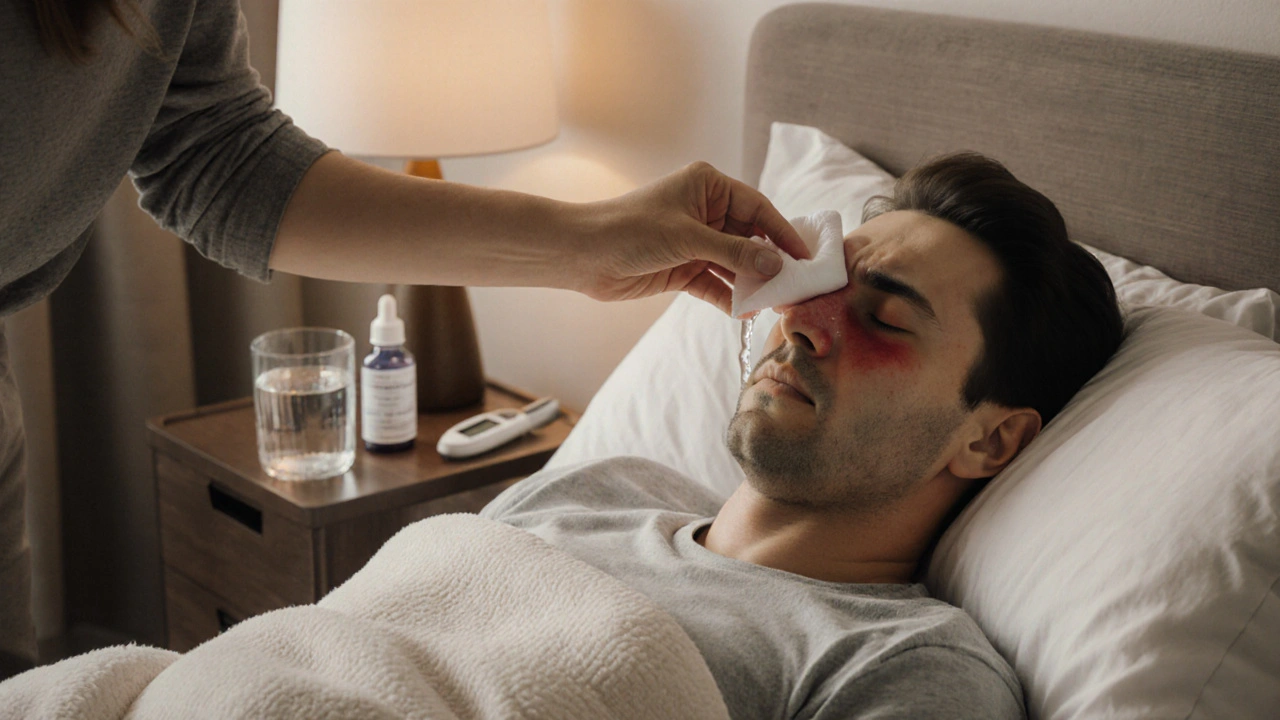Postoperative ocular inflammation is a condition marked by swelling, redness, discomfort and sometimes blurred vision after eye surgery. It can feel alarming for both the patient and their family, but the right support makes recovery smoother. Below you’ll find a hands‑on guide to help a loved one navigate this tricky phase.
What Exactly Is Post‑Surgery Eye Inflammation?
After procedures such as cataract surgery or laser‑assisted in‑situ keratomileusis (LASIK), the eye’s delicate tissues react. Inflammation is part of the natural healing cascade, but when it spikes it can cause noticeable redness, a gritty sensation, and photophobia. The inflammation is driven by the release of prostaglandins and cytokines, which increase blood flow to the area and attract immune cells.
Common Triggers and Typical Signs
- Any intra‑ocular procedure - cataract extraction, retinal repair, or glaucoma tube placement - can spark a flare‑up.
- Dry‑eye syndrome, which often worsens after surgery, may amplify the inflammatory response.
- Early signs include a pink or blood‑shot eye, swelling of the eyelids, and a sensation of a foreign body.
- Vision may be hazy for a day or two, but should steadily improve as the swelling recedes.
Keeping a log of these symptoms helps the ophthalmologist fine‑tune treatment and reassures the family that progress is being monitored.
Core Treatment Options
Doctors usually prescribe one or more of the following to calm the eye:
- Topical steroid eye drops - potent anti‑inflammatory agents that reduce swelling within hours.
- Non‑steroidal anti‑inflammatory eye drops (NSAID drops) - gentler than steroids, useful for prolonged therapy.
- Oral corticosteroids - reserved for severe cases where topical drops aren’t enough.
Each option has trade‑offs, which we break down in the table below.
| Treatment | Onset of Action | Typical Duration | Key Side Effects | Prescription Needed? |
|---|---|---|---|---|
| Topical steroid drops | 1-2 hours | 5-7 days (tapered) | Increased intra‑ocular pressure, cataract acceleration | Yes |
| NSAID eye drops | 2-4 hours | 7-14 days | Corneal irritation, rare allergic reaction | Yes |
| Oral corticosteroids | 4-6 hours | 3-5 days (high dose) then taper | Weight gain, mood swings, glucose spikes | Yes |
Practical Ways to Support Your Loved One
Being there goes beyond handing over medication. Consider these steps:
- Medication Management: Set up a pill‑box or phone reminder for each drop. Most eye‑drop regimens require precise timing - often four times a day.
- Help with Application: Many patients find it tricky to instill drops without touching the eye. Offer a steady hand or a mirror positioned at eye level. A gentle pull‑down of the lower eyelid creates a pocket for the drop.
- Comfort Measures: Apply a cold compress for 10‑minute intervals, three times daily. This reduces vascular congestion and eases pain.
- Environmental Adjustments: Dim bright lights, avoid wind, and keep the room at a comfortable humidity (40‑60%). Use a humidifier if the air feels dry.
- Emotional Support: Reassure them that temporary visual blur is normal. Remind them of the long‑term vision gains they’re working toward.
Managing Pain and Discomfort
Most pain is mild, but a few people experience throbbing that interferes with sleep. Strategies include:
- Over‑the‑counter acetaminophen (500mg) every 6hours, unless contraindicated.
- A thin eye patch during short naps can protect the eye from accidental rubbing.
- Gentle eyelid massage (with clean hands) after a cold compress can encourage lymphatic drainage.

Nutrition and Lifestyle Tweaks
What you eat can subtly influence inflammation:
- Omega‑3‑rich foods - salmon, walnuts, flaxseed - have mild anti‑inflammatory effects.
- Limit processed sugars and saturated fats, which can exacerbate systemic inflammation.
- Stay well‑hydrated; tear film quality improves with adequate fluid intake.
Encourage short walks and light stretching; circulation aids healing, but avoid heavy lifting for the first week.
Red Flags - When to Call the Doctor
Even with diligent care, certain signs warrant immediate medical attention:
- Sudden vision loss or new floaters.
- Severe eye pain unrelieved by prescribed meds.
- Swelling that worsens after 48hours despite treatment.
- Discharge that is thick, yellow, or foul‑smelling - could indicate infection.
Having the doctor’s after‑hours number saved on your phone can reduce anxiety for both parties.
Related Concepts Worth Exploring
Understanding the broader picture helps you anticipate future needs. Post‑operative eye inflammation often co‑exists with:
- dry eye syndrome - reduced tear production that can prolong irritation.
- post‑operative infection - a rarer but serious complication requiring antibiotics.
- Visual recovery timelines - patients typically regain full acuity within 2-4weeks, depending on the surgery type.
Future reads could dive deeper into dry‑eye management or the role of ocular lubricants after surgery.
Quick Recap
- Know the signs: redness, swelling, mild pain, blurred vision.
- Support medication adherence and correct drop technique.
- Use cold compresses, eye patches, and OTC pain relief wisely.
- Watch for red‑flag symptoms and contact the ophthalmologist promptly.
- Encourage anti‑inflammatory foods, hydration, and a calm environment.
Frequently Asked Questions
How long does postoperative eye inflammation usually last?
Most mild cases subside within 5‑7days with proper drops. More severe inflammation can take up to two weeks, but vision typically keeps improving throughout that period.
Can I use over‑the‑counter eye drops instead of prescription ones?
OTC lubricating drops help with dryness but do not address the inflammatory process. Prescription steroids or NSAID drops are needed to taper swelling effectively.
Is it safe to drive while my loved one’s eye is still inflamed?
Avoid driving if vision is blurry, if glare is strong, or if the patient feels discomfort that distracts. Most surgeons advise waiting until the eye is clear enough to see road signs and read mirrors reliably.
What if the prescribed steroid drops cause increased eye pressure?
Elevated intra‑ocular pressure is a known side‑effect. The ophthalmologist may lower the dose, switch to NSAID drops, or add pressure‑lowering medication. Monitoring with a tonometer at follow‑up visits is essential.
Can I help with eye‑drop administration if I’m not a medical professional?
Yes. Wash your hands thoroughly, use a clean tissue to prevent contamination, and gently pull down the lower eyelid to create a pocket. If you’re unsure, ask the clinic for a short demo before leaving the appointment.
Should my loved one avoid makeup or creams around the eyes?
It’s best to skip eye makeup and heavy creams for at least a week. Anything that could enter the eye may cause irritation or infection. Gentle, fragrance‑free moisturizers applied away from the lid margin are acceptable after the first 48hours.

Jason Divinity
September 27, 2025 AT 19:23In the wake of ocular surgery, the cascade of inflammation is a physiological orchestra, yet its overture can be disquieting for caregivers; understanding the biochemical symphony is paramount to effective support.
andrew parsons
September 28, 2025 AT 21:37One must remember that negligence in medication timing constitutes a breach of duty to the patient!⏰🩺 Ensure each drop is administered with the precision of a Swiss watch; otherwise, the inflammation may spiral unchecked. 📅
Sarah Arnold
September 29, 2025 AT 23:52💡 Practical tip: set a recurring alarm on your phone for every dosing interval and keep the eye‑drop bottle on a nightstand so you don’t have to scramble in the dark. A gentle pull‑down of the lower lid creates a pocket that helps the drop stay where it belongs.
Rajat Sangroy
October 1, 2025 AT 02:06Exactly! And don’t forget to pair those reminders with a quick 10‑minute cold compress – it’s like giving the inflamed tissue a soothing ice‑cream break. Keep the room humidity up, too; dry air just fuels the fire.
dany prayogo
October 2, 2025 AT 04:21Ah, the ever‑expansive handbook of post‑operative eye care, a veritable labyrinth of dos and don’ts that would befuddle even the most seasoned ophthalmologist. One might wonder, dear readers, whether the author truly considered the emotional toll upon the layperson tasked with juggling drops, compresses, and dietary adjustments. The prose, while thorough, assumes a level of dedication that borders on monastic devotion – a point that should not escape scrutiny. It is, perhaps, an oversight to neglect the simple fact that many caregivers work full‑time jobs and cannot dedicate half‑hours every few hours to ocular hygiene. Moreover, the emphasis on omega‑3 supplementation, though scientifically sound, presumes access to fresh salmon or premium supplements, which might be a luxury in certain socioeconomic strata. The suggestion to avoid makeup for a week is sensible, yet it fails to acknowledge cultural practices where eye‑enhancing cosmetics hold symbolic significance. In addition, the described cold compress regimen, while effective, could be replaced with readily available chilled spoons – an improvisational tip that would resonate with budget‑conscious families. The red‑flag list, though comprehensive, could be streamlined; a concise bullet‑point table would aid rapid reference in moments of panic. The author’s tone remains disarmingly clinical, lacking the warmth that could reassure a frightened loved one. One must also critique the omission of tele‑medicine options, which have become a mainstay in post‑operative monitoring. Finally, the repeated use of technical jargon such as “prostoglandins” and “cytokines” may alienate the very audience the article seeks to empower. In short, while the guide is a commendable effort, it would benefit immensely from a more empathetic, inclusive, and pragmatic approach.
Sharif Ahmed
October 3, 2025 AT 06:35Indeed, the piece teeters between brilliance and pretension, much like a maestro who forgets the audience’s yearning for melody.
Charlie Crabtree
October 4, 2025 AT 08:49Great tips, thanks! 😊
RaeLyn Boothe
October 5, 2025 AT 11:04While your enthusiasm is appreciated, please remember not to overstep personal boundaries when assisting with eye‑drops; consent is key.
Fatima Sami
October 6, 2025 AT 13:18Ensure the patient maintains a log of medication times; accurate records facilitate swift adjustments by the ophthalmologist.
Arjun Santhosh
October 7, 2025 AT 15:33Totally agree-its helps a lot. Also, dont forget to keep the bottle clean!
Stephanie Jones
October 8, 2025 AT 17:47One could muse that the eye, a translucent portal, mirrors our own vulnerability; the postoperative haze becomes a metaphor for life's inevitable uncertainties.
Nathan Hamer
October 9, 2025 AT 20:01Beautifully put! 🌟 Remember, though, to keep the practical steps close at hand – routine drops, cool compresses, and a dash of optimism can turn that metaphor into a hopeful reality.
Tom Smith
October 10, 2025 AT 22:16Well, if we’re doling out sage advice, let’s remember that “just follow the doctor’s orders” is not a novel suggestion, but it does cut through the noise.
Kyah Chan
October 12, 2025 AT 00:30While your sarcasm entertains, the factual content regarding intra‑ocular pressure monitoring should be highlighted with greater seriousness.
Ira Andani Agustianingrum
October 13, 2025 AT 02:45Hey team, keep the encouragement flowing! A quick reminder: hydrate well, snack on anti‑inflammatory foods, and celebrate small milestones – like a clear eye after a day of drops.
James Higdon
October 14, 2025 AT 04:59It is ethically imperative to stress that neglecting these simple health practices borders on moral irresponsibility; we owe our loved ones diligent care.